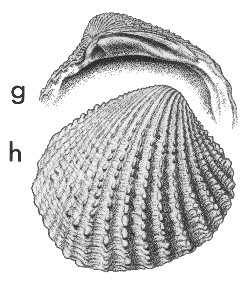
Revised descriptions of New Zealand Cenozoic Mollusca from Beu and Maxwell (1990)

 | Revised descriptions of New Zealand Cenozoic Mollusca from Beu and Maxwell (1990) | 
|
  (Pl. 5g, h): GS1988, J40/f8457, abandoned railway cutting, South Branch, Waihao River near Waihao Downs, Bortonian (GNS) |
Beu & Maxwell (1990): Chapter 7; p. 101; pl. 5 g, h.
Synonymy: Venericardia acanthodes Suter 1917, p. 72-73; V. (Fasciculicardia) acanthodes
Classification: Carditidae: Venericardiinae
Description: Size moderate for family (length 25-37 mm), ovate-subquadrate, posterior end only weakly truncate; posterior area weakly defined. Lunule small, strongly pouting. Radial sculpture of 21-24 prominent costae with broadly triangular- sectioned bases and elevated crests, those on flanks with much wider interspaces than those on posterior area or near anterior end. Medial costae flanked by much weaker ridges producing the tripartite (or "fasciculate") sculpture characteristic of the genus. All costae with laterally compressed nodules or tubercles on crests producing a distinctly serrate profile, those on posterior area (except for second and third costae from posterodorsal margin) much less prominent than on rest of shell. Commarginal sculpture of fine wrinkle-like ridges and numerous very fine threadlets between costae. Left valve with a very small tubercular anterior lateral tooth at end of lunular groove, small triangular anterior cardinal tooth and long, curved posterior cardinal; right valve with short, narrow anterior cardinal tooth fused to lunule and a prominent, broadly curved-triangular median cardinal tooth. Distal end of left lunule produced into small tubercular lateral tooth fitting into socket on right valve.
Comparison: Glyptoactis (Fasciculicardia) subintermedia (PI. 23g) is similar to G. acanthodes in general appearance, but grows to a much larger size, has more numerous radial costae (28-31) and has a broader left anterior cardinal tooth which is almost fused to the lunule rather than separated by a definite socket. G. healyi (Bortonian, Pahi, Kaipara Harbour) is similar in age to G. acanthodes but has more numerous (30- 33), more closely spaced radial costae with much more pronounced secondary costellae. The presence of tripartite costae in these species (and in G. benhami (PI. 9c, d)) sets them apart from other New Zealand venericardiines and suggests closer relationship to Glyptoactis Stewart, 1930 than to Venericardia Lamarck, 1801, which has simple costae. Chavan (in Moore 1969, p. N556) separated Glyptoactis and its relatives from Venericardia at the subfamilial level, but this radical classification is not followed here. The distribution of Glyptoactis (Fasciculicardia) in the New Zealand Cenozoic suggests it was a warm-water group (see discussion on G. subintermedia).
Distribution: Bortonian, Waihao Greensand, Waihao Downs (type) (common); Hampden Beach (rare).
Cite this publication as: "A.G. Beu and J.I. Raine (2009). Revised
descriptions of New Zealand Cenozoic Mollusca from Beu and Maxwell (1990). GNS
Science miscellaneous series no. 27."
© GNS Science, 2009
ISBN
978-0-478-19705-1
ISSN 1177-2441
(Included with a PDF facsimile file
copy of New Zealand Geological Survey Paleontological Bulletin 58 in CD version
from: Publications Officer, GNS Science, P.O. Box 30368 Lower Hutt, New
Zealand)